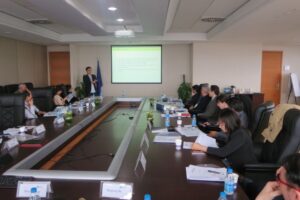
Is FRM the Best Course? Exploring Financial Risk Management and Its Career Impact
Is FRM the Best Course? Exploring Financial Risk Management and Its Career Impact
In today’s fast-changing financial world, risk is an unavoidable reality. Organisations face constant exposure to risks such as market fluctuations, credit defaults, and operational disruptions. To manage these effectively, they need experts who can identify, analyse, and mitigate financial risks.
The Financial Risk Manager (FRM) designation is a globally recognised credential. It certifies professionals with the expertise to assess and control financial risk.
With many finance-related programmes available, a common question arises — is FRM the best course for your career? This article explores FRM course details such as duration, cost, and learning outcomes. It also introduces an excellent alternative — the Post Graduate Diploma in Risk Management (PGDRM) from GRMI, an industry-aligned, practical programme based in India.
Understanding FRM and Its Meaning
Before choosing FRM, it’s important to understand what it means. FRM stands for Financial Risk Manager, a certification for professionals skilled in identifying, analysing, and managing risks within financial systems.
The FRM course focuses on key areas like credit risk, market risk, operational risk, and liquidity risk. It helps candidates build strong analytical and quantitative skills for better decision-making.
More than just theory, FRM develops professionals who use data and strategy to protect firms from unexpected losses. It aims to build resilience and guide organisations toward long-term stability.
FRM Course Structure: What Does It Include?
The FRM course follows a rigorous and well-structured curriculum that covers both fundamental and advanced aspects of risk management. It addresses areas such as quantitative analysis, valuation, financial markets, credit risk, operational risk, and risk modelling.
This comprehensive approach equips learners to apply critical thinking to real-world challenges, assess risks logically, and make informed decisions in professional settings.
FRM Course Duration: How Long Does It Take?
The duration of the FRM course is flexible. Most candidates complete both levels within one to two years, depending on their preparation pace.
This flexibility benefits students and working professionals who want to enhance their skills without pausing their careers. The adaptable schedule makes FRM a popular choice for finance aspirants worldwide.
FRM Course Fees and Financial Investment
The cost of pursuing FRM depends on registration time, study materials, and learning methods. Typically, the total fees include exam registration, study resources, and optional coaching.
While the investment can seem high, it should be viewed as a long-term career asset. FRM certification is globally valued and can significantly boost earning potential.
However, for those seeking a structured, placement-supported academic experience, GRMI’s PGDRM programme offers an equally strong, and often more practical, pathway.
Career Opportunities After Earning FRM Certification
An FRM certification opens doors to several high-value roles, including:
- Risk Analyst
- Market Risk Manager
- Credit Risk Manager
- Financial Consultant
- Treasury and Compliance Manager
These positions exist across banking, insurance, consulting, and investment management sectors. Demand for skilled risk professionals continues to grow as regulations and global challenges evolve.
This wide scope makes FRM one of the most rewarding certifications for finance professionals aiming to work internationally.
Alternatives to FRM: GRMI’s PGDRM Programme
While FRM holds global recognition, it isn’t the only credible route to mastering risk management. For those seeking industry exposure and practical knowledge, the Post Graduate Diploma in Risk Management (PGDRM) by GRMI stands out.
The PGDRM programme blends theory with practical learning through live simulations, projects, and industry collaboration. Designed by industry leaders, it prepares graduates to manage diverse risks — including financial, operational, and cyber risks.
Why GRMI’s PGDRM is a Strong Alternative
- Comprehensive Curriculum: Covers financial, enterprise, and regulatory risk for a complete understanding of the discipline.
- Practical Exposure: Emphasises hands-on learning through simulations, live projects, and case studies.
- Industry Mentorship: Taught by professionals from consulting, finance, and analytics sectors.
- Strong Placement Record: GRMI partners with leading companies to provide assured placement opportunities.
- One-Year Duration: Offers intensive learning and career advancement in a shorter time frame.
In essence, GRMI’s PGDRM offers the rigour of FRM certification combined with mentorship and real-world experience.
FRM vs PGDRM: Which Is Better for You?
Choosing between FRM and PGDRM depends on your learning style and career goals.
- FRM is best for self-directed learners seeking a globally recognised financial certification. It suits those already focused on finance careers.
- PGDRM (GRMI) is ideal for those who prefer structured guidance, practical application, and direct industry engagement. It’s particularly valuable for recent graduates and early-career professionals
The Importance of Risk Management Today
In an interconnected global economy, financial risks are becoming more complex. The COVID-19 pandemic, inflation, and rapid digitalisation have shown how crucial risk professionals are to organisational stability.
Both FRM and GRMI’s PGDRM play vital roles in preparing professionals for these challenges. Each programme builds knowledge, adaptability, and analytical thinking — essential for risk management careers worldwide.
If you want a self-paced global certification, FRM is a solid choice.
If you prefer a guided, application-based, industry-oriented programme, GRMI’s PGDRM delivers unmatched value.
Final Thoughts: Building a Career in Risk Management
Understanding the FRM course structure, duration, and fees helps evaluate its worth. FRM remains one of the most respected certifications for finance professionals.
However, for a more comprehensive and experiential learning journey, GRMI’s Post Graduate Diploma in Risk Management offers a deeper understanding of risk with strong placement support.
Whether you pursue FRM or GRMI’s PGDRM, both open doors to a rewarding and future-ready career. For learners seeking structured mentorship and immersive exposure, GRMI provides the ideal foundation to take the first confident step toward success.
FAQ’s
Q1: What is FRM in its entirety?
Ans: Financial Risk Manager, or FRM for short, is a widely accepted risk management qualification.
Q2: How long does the FRM course take to finish?
Ans: Depending on their schedule and amount of preparation, most applicants complete both FRM levels in one to two years.
Q3: Does FRM outperform CFA?
Ans: Both are distinguished. Whereas CFA deals with investment and portfolio management, FRM concentrates on risk management. The decision is based on your professional objectives.
Q4: Can I continue with FRM once I graduate?
Ans: Graduates from any field are welcome to enrol. Although not required, a background in mathematics, economics, or finance is advantageous.
Q5: What distinguishes the PGDRM programme at GRMI?
Ans: The PGDRM from GRMI combines theory and practical application. It gives students a competitive edge in the risk management industry by providing mentorship, practical projects, and placement assistance that is guaranteed.
For any queries please fill the form
Tag:frm
You may also like

Top Specialised Courses for Graduates

7 Promising Career Paths and Courses After BCom


